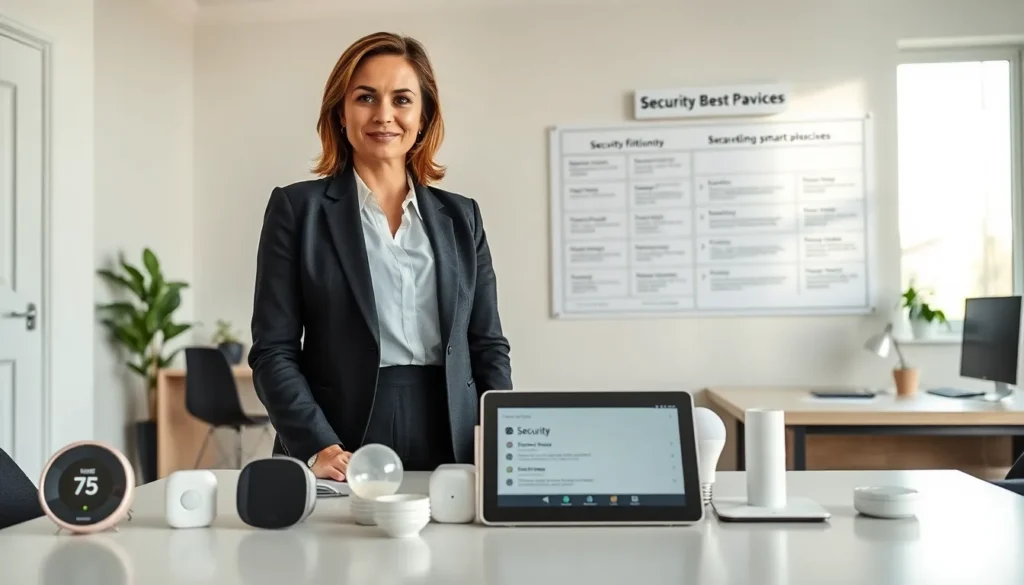In a world where everything from your lights to your fridge can be smarter than your average bear, securing smart home devices has never been more critical. Picture this: You’re on a well-deserved vacation, sipping a tropical drink, and suddenly realize you’ve forgotten to secure your smart doorbell. What if it turns into a portal for some digital mischief-maker? Fear not. This guide is here to keep your digital life safe while you enjoy your real one. Let’s jump into the nitty-gritty of keeping those techy gadgets safe from prying eyes and mischievous hands.
Table of Contents
ToggleUnderstanding Smart Home Security Risks

Common Vulnerabilities in Smart Devices
Smart devices might seem innocuous, but they often come with vulnerabilities that make them prime targets for cybercriminals. For starters, many devices have hard-coded passwords or default settings that can be exploited. Even the most innocuous items, like smart light bulbs, can become gateways for hackers if not secured.
Another common issue involves outdated software. Many users set up devices but neglect to update their firmware, leaving them exposed to well-documented exploits. The fact is, smart home systems are only as secure as their weakest link – and often, that’s the user’s negligence.
Potential Consequences of Poor Security Practices
Imagine waking up one morning to find your smart thermostat has been cranked up or your security camera has been disabled. Poor security practices can lead to unauthorized access, identity theft, or even physical theft. In the worst-case scenario, a hacker could gain access to your home network, making it possible to control all devices connected to it. This could lead to devastating consequences, including compromised personal information and privacy violations.
Best Practices for Securing Smart Home Devices
Changing Default Passwords and Username
One of the simplest yet most effective ways to secure smart home devices is to change the default passwords and usernames. When setting up devices, users often overlook the importance of this step. Make it a habit to change these settings as soon as you unpack the device – this is your first line of defense against intruders.
Regular Software Updates and Firmware Upgrades
Nothing says “hack me” like outdated software. Manufacturers frequently release updates to patch security vulnerabilities, so it’s essential to keep your devices up to date. Enable automatic updates wherever possible, or set reminders on your calendar to check for updates regularly.
Using Strong, Unique Passwords
Implementing strong, unique passwords can feel like a chore, but it does wonders for device security. Try using a password manager to create complex passwords that are tough to crack but easy for you to remember. A combination of uppercase, lowercase, numbers, and symbols should do the trick.
Enabling Two-Factor Authentication
When available, two-factor authentication (2FA) serves as a critical layer of security. This feature typically requires you to enter a second code sent to your mobile device or email, making it harder for attackers to gain access even if they have your password. Take advantage of this feature: it’s a simple way to ramp up your security.
Network Security Measures
Using a Strong Wi-Fi Password
Another essential step is securing your home Wi-Fi network. Using a strong password that mixes alphanumeric characters and symbols will deter unauthorized users. Avoid using easily guessable information, such as birthdays or common words.
Setting Up a Separate Network for IoT Devices
Creating a separate network for your Internet of Things (IoT) devices can provide an additional safety net. If hackers infiltrate your smart refrigerator, they won’t have direct access to your computer or smartphone. Isolate your IoT devices on their own network to add an extra layer of security.
Implementing a Firewall
By implementing a firewall, you can block unwanted incoming traffic to your network. Most modern routers come with built-in firewalls, but ensure that they’re activated. A firewall can be one of the most effective measures in enhancing your network security.
Monitoring Smart Device Activity
Signs of Unauthorized Access to Devices
It’s crucial to monitor the activity of your smart devices actively. Unusual behaviors, such as devices turning on or off without prompting, or unexpected notifications, can indicate unauthorized access. Staying vigilant can help catch security breaches before they escalate.
Tools for Monitoring Device Security
Various tools can help monitor the security of your smart home devices. Integrating network scanning tools will provide insights into all connected devices and alert you of any unauthorized ones. Also, many smart device manufacturers offer companion apps that include security monitoring features: be sure to take advantage of these offerings.













